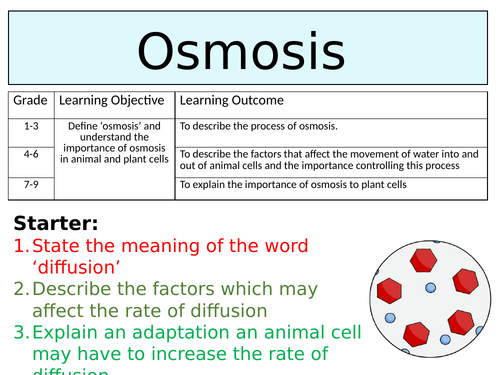
This is a lesson designed to meet specification points for the new OCR GCSE (Gateway) Biology 'Scaling up’ scheme of work.
This lesson begins with a definition for osmosis and defining the difference between solvent and solutes. Pupils are then asked to think > pair > share about what they think a partially permeable membrane might be.
In the next activity, pupils are given a definition for concentrated and dilute solutions and are shown three different diagrams, they need to decide whether they are showing pure water, a concentrated or a dilute solution.
Now pupils are introduced to isotonic, hypertonic and hypotonic solutions. They are firstly shown what happens to animals cells in each of these solutions using an animation. Pupils will then need to match the type of solution to it’s description and also complete a cartoon strip to explain what happens to animal cells in each of these solutions, a list of key words is provided.
Students will then think about the importance of osmosis to plants and will need to match diagrams of plant cells in isotonic/hypertonic/hypotonic solutions to the correct description.
The last activity is an exam-style question on osmosis, pupils can self-assess their work using the mark scheme provided.
The plenary task is for pupils to write 5 summary sentences about what they have learnt so far using the list of key words provided.
All resources are included in the PowerPoint presentation, thank you for purchasing :)
Get this resource as part of a bundle and save up to 61%
A bundle is a package of resources grouped together to teach a particular topic, or a series of lessons, in one place.
Something went wrong, please try again later.
This resource hasn't been reviewed yet
To ensure quality for our reviews, only customers who have purchased this resource can review it
Report this resourceto let us know if it violates our terms and conditions.
Our customer service team will review your report and will be in touch.
